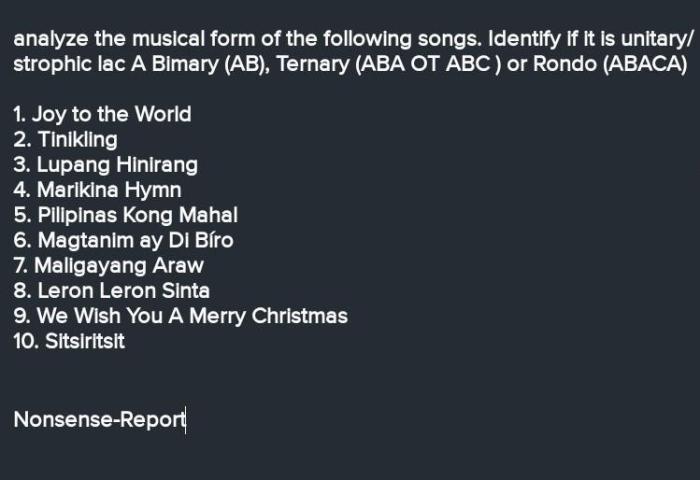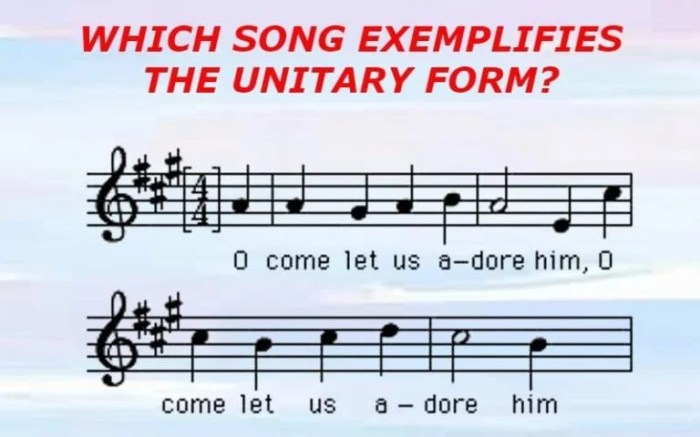The following musical excerpt represents strophic form, a musical structure characterized by the repetition of identical or similar musical phrases over different lyrics. This form is prevalent in various musical genres, including folk songs, hymns, and popular music, and has been employed by composers for centuries to create memorable and impactful melodies.
Strophic form offers a unique blend of simplicity and effectiveness, making it an enduring choice for musicians. Its repetitive structure provides a sense of familiarity and accessibility, while the variations in lyrics allow for storytelling and emotional expression. In this analysis, we will explore the defining characteristics of strophic form, examine its historical and cultural context, and discuss its impact on musical composition and performance.
Strophic Form Definition: The Following Musical Excerpt Represents Strophic Form

Strophic form is a musical structure in which a single melody is repeated throughout the piece, with different lyrics for each verse.
Examples of strophic form include “Twinkle, Twinkle, Little Star” and “Amazing Grace.”
Characteristics of Strophic Form
- Repeated melody throughout the piece
- Different lyrics for each verse
- Simple and easy to sing
- Often used in folk songs and hymns
Variations of Strophic Form, The following musical excerpt represents strophic form
Verse-Chorus Form
Verse-chorus form is a variation of strophic form in which the melody is repeated for the verses, but a different melody is used for the chorus.
Examples of verse-chorus form include “I Will Survive” and “Sweet Home Alabama.”
Strophic Variation Form
Strophic variation form is a variation of strophic form in which the melody is slightly varied for each verse.
Examples of strophic variation form include “Amazing Grace” and “Greensleeves.”
Historical and Cultural Context
Strophic form has been used in music for centuries, and it can be found in a variety of musical genres and cultures.
Some of the earliest examples of strophic form can be found in medieval folk songs and hymns.
Strophic form is still used in popular music today, and it can be found in songs by artists such as Bob Dylan and Bruce Springsteen.
Analytical Techniques
There are a number of analytical techniques that can be used to identify and analyze strophic form in musical excerpts.
These techniques include:
- Musical notation
- Melodic patterns
- Lyrical structure
Impact and Significance
Strophic form has had a significant impact on music.
Its simplicity and accessibility have made it a popular form for folk songs and hymns.
Strophic form has also been used by composers of popular music, and it has helped to shape the sound of many of our favorite songs.
Top FAQs
What is the main characteristic of strophic form?
The main characteristic of strophic form is the repetition of identical or similar musical phrases over different lyrics.
What are some examples of songs that use strophic form?
Examples of songs that use strophic form include “Twinkle, Twinkle, Little Star,” “Amazing Grace,” and “Happy Birthday to You.”
How does strophic form contribute to the overall impact of a song?
Strophic form contributes to the overall impact of a song by creating a sense of familiarity and accessibility, while the variations in lyrics allow for storytelling and emotional expression.


